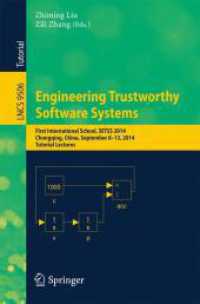- ホーム
- > 洋書
- > 英文書
- > Science / Mathematics
Full Description
This volume is designed to impart the fundamental concepts in experimental pharmacology, research methodology and biostatistics. Through this book, the readers will learn about different methods involved in drug discovery, experimental animals and their care, equipments and the various bioassays used in experimental pharmacology. This book contains special sections on various drug screening methods involved in the evaluation of different body systems. Certain sections provide the healthcare professionals with the knowledge necessary to interpret clinical research articles, design clinical studies, and learn essential concepts in biostatistics in an expedient and concise manner. Basic principles and applications of simple analytical methods employed in drug analysis are well written under one section.
It focuses on the basic and advanced laboratory techniques and also on computer simulated data, written extensively under the Biostatistics section. The methods used for drug analysis have been described in adequate detail with cross-references for further studies and comprehension. Overall, the book is designed systematically with four broad sections with extensive subdivisions for easy tracking, interpretation, and understanding.
Contents
1. Experimental methodologies involved in the discovery of drugs.- 2. Laboratory animals.- 3. Care and Handling of Laboratory Animals.- 4. Biological Sample Collection from Experimental Animals.- 5. Anaesthesia and Euthanasia of Experimental Animals.- 6. Equipment in experimental Pharmacology.- 7. Bioassay and experiments on isolated muscle preparations.- 8. Experiments on Anaesthetized Intact Animals.- 9. Bioassay of standard compounds.- 10. PRINCIPLES OF EC50, ED50, pD2 and pA2 VALUES OF DRUGS.- 11. Physiological salt solutions.- 12. Validation of animal model.- 13. Screening Methods for the Evaluation of Antidepressant Drugs.- 14. Screening methods for evaluation of antiepileptics.- 15. Screening Methods Involved in the Evaluation of General Anaesthetics.- 16. Screening methods for evaluation of anti-psychotics.- 17. Screening methods for evaluation of sedative and hypnotics.- 18. Screening Methods for the Evaluation of Anxiolytic Drugs.- 19. Screening methods for evaluation of drugs with Anti-Parkinsonism activities.- 20. Screening methods for evaluation of drugs for learning and memory.- 21. Screening Methods Involved in the Evaluation of Antianginal Agents.- 22. Screening methods involved in the evaluation of Anti-hypertensive agents.- 23. Screening methods involved in the evaluation of anti arrhythmic agents.- 24. Screening methods involved in evaluation of cardiotonic drugs (Cardiac Hypertrophy and Insufficiency/ Drugs for Heart Failure).- 25. Screening Methods for the Evaluation of Antiplatelet Drugs.- 26. Screening methods involved in the evaluation of diuretics.- 27. Screening Methods for anti-hyperlipidemic agents.- 28. Screening Methods Involved in the Evaluation of Antiulcer Drugs.- 29. Screening Methods Involved in the Evaluation of Antidiarrheal Drugs (Drugs Affecting Intestinal Motility and Secretion).- 30. Screening Methods Involved in the Evaluation of Antiemetics.- 31. Screening Methods for the Evaluation of Hepatoprotective Agents.- 32. Screening Methods for the Evaluation of Anti-obesity Drugs.- 33. Absorption studies.- 34. Screening methods for evaluation of anti-asthma agents.- 35. Screening Methods for Evaluation of Antitussives and Expectorants.- 36. Screening methods involved in the evaluation of anti-diabetic drugs.- 37. Screening Methods for the Evaluation of Antithyroid Drugs.- 38. Screening methods for evaluation of antifertility drugs.- 39. Screening methods for evaluation of Posterior Pituitary, Adrenal Steroid, Testicular, Parathyroid, Ovarian, and Thyroid Hormones.- 40. Screening methods involved in the evaluation of drugs with analgesic, anti-inflammatory, and antipyretic activity.- 41. Screening Methods Involved in the Evaluation of Drugs with Ophthalmologic Activity.- 42. SCREENING METHODS FOR THE EVALUATION OF DRUGS AFFECTING PERIPHERAL NERVE FUNCTION.- 43. MUTAGENIC TOXICITY TESTING.- 44. Screening methods for evaluation of anticancer drugs.- 45. Screening Methods Involved in the Evaluation of Drugs for Benign Prostatic Hyperplasia.- 46. Evaluation of Drugs Acting on Autonomic Nervous System.- 47. Screening Methods for the Evaluation of Antifungal, Anthelminthic, Antibacterial, and Antiviral Agents.- 48. Preclinical toxicity studies.- 49. Ethical Issues in Animal Research.- 50. Good Laboratory Practice (GLP).- 51. Basic principles and applications of simple analytical methods.- 52. Principles of Quantitative Estimation of Drugs, Endogenous Compounds, and Poisons.- 53. Principles of quantitative estimation of drugs, endogenous compounds, and poisons - 2.- 54. Plant extraction methods.- 55. Literature search.- 56. STUDY DESIGNS.- 57. Ethical Issues Related to Medical Research on Human Participants.- 58. Basic principles and application of statistics in drug research.- 59. Calculation of Basic Statistical Parameters.- 60. Hypothesis Testing.- 61. Parametric tests.- 62. NON-PARAMETRIC TESTS.- 63. Common errors in using statistical tools and data presentation.






